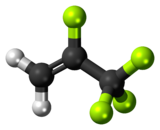HFO-1234yf
 |
|
 |
|
| Names | |
|---|---|
|
Preferred IUPAC name
2,3,3,3-Tetrafluoroprop-1-ene
|
|
| Other names
HFO-1234yf; R1234yf; R-1234yf; 2,3,3,3-Tetrafluoropropylene
|
|
| Identifiers | |
|
3D model (JSmol)
|
|
| ChemSpider | |
| ECHA InfoCard | 100.104.879 |
|
|
|
|
| Properties | |
| C3H2F4 | |
| Molar mass | 114 g/mol |
| Appearance | colorless gas |
| Density | 1.1 g/cm3 at 25 °C (liquid); 4, air = 1 (gas) |
| Boiling point | −30 °C (−22 °F; 243 K) |
| 198.2 mg/l at 24 °C, 92/69/EEC, A.6 | |
| log P | 2.15, n-octanol/water, 92/69/EEC, A.8 |
| Vapor pressure | 6,067 hPa at 21.1 °C; 14,203 hPa at 54.4 °C |
| Hazards | |
| 405 °C (761 °F; 678 K) | |
| Explosive limits | 6.2 %(v); 12.3 %(v) |
|
Except where otherwise noted, data are given for materials in their standard state (at 25 °C [77 °F], 100 kPa).
|
|
|
|
|
| Infobox references | |
2,3,3,3-Tetrafluoropropene, or HFO-1234yf, is a hydrofluoroolefin (HFO) with the formula CH2=CFCF3. This colorless gas has been proposed as a replacement for R-134a as a refrigerant in automobile air conditioners.
HFO-1234yf is the first in a new class of refrigerants acquiring a global warming potential (GWP) rating 1⁄335 that of R-134a and only 4 times higher than carbon dioxide.
HFO-1234yf was developed to meet the European directive 2006/40/EC that went into effect in 2011 requiring that all new car platforms for sale in Europe use a refrigerant in its AC system with a GWP below 150.
HFO-1234yf, which has a 100-year GWP lower than 1, could be used as a "near drop-in replacement" for R-134a, the current product used in automobile AC systems, which has a 100-year GWP of 1430. This means that automakers would not have to make significant modifications in assembly lines or in vehicle system designs to accommodate the product. HFO-1234yf has the lowest switching cost for automakers among the currently proposed alternatives, although the initial cost of the product is much higher than that of R-134a. The product could be handled in repair shops in the same way as R-134a, although it would require different, specialized equipment to perform the service. One of the reasons for that is the mild flammability of HFO-1234yf. Another issue affecting the compatibility between HFO-1234yf and R-134a-based systems is the choice of lubricating oil. The current lubricating oil is showing signs of damage to plastic and aluminium, and issues with health, including mouth dryness, rashes, and sore throat, among other effects.
Shortly after confirmation from automakers that HFO-1234yf would be adopted as a replacement of R-134a automotive air-conditioning refrigerant, Honeywell and DuPont announced jointly built a manufacturing facility in Changshu, Jiangsu Province, China to produce HFO-1234yf. In addition, Honeywell is building a new plant in Geismar, Louisiana, USA to produce the new refrigerant as well. Although others claim to be able to make and sell HFO-1234yf, Honeywell and DuPont hold most or all of the patents registered for HFO-1234yf.
...
Wikipedia
